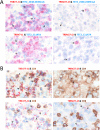Angioimmunoblastic T-cell lymphoma contains multiple clonal T-cell populations derived from a common TET2 mutant progenitor cell
- PMID: 31859368
- PMCID: PMC7064999
- DOI: 10.1002/path.5376
Angioimmunoblastic T-cell lymphoma contains multiple clonal T-cell populations derived from a common TET2 mutant progenitor cell
Abstract
Angioimmunoblastic T-cell lymphoma (AITL) is a neoplastic proliferation of T follicular helper cells with clinical and histological presentations suggesting a role of antigenic drive in its development. Genetically, it is characterized by a stepwise acquisition of somatic mutations, with early mutations involving epigenetic regulators (TET2, DNMT3A) and occurring in haematopoietic stem cells, with subsequent changes involving signaling molecules (RHOA, VAV1, PLCG1, CD28) critical for T-cell biology. To search for evidence of potential oncogenic cooperation between genetic changes and intrinsic T cell receptor (TCR) signaling, we investigated somatic mutations and T-cell receptor β (TRB) rearrangement in 119 AITL, 11 peripheral T-cell lymphomas with T follicular helper phenotype (PTCL-TFH), and 25 PTCL-NOS using Fluidigm polymerase chain reaction (PCR) and Illumina MiSeq sequencing. We confirmed frequent TET2, DNMT3A, and RHOA mutations in AITL (72%, 34%, 61%) and PTCL-TFH (73%, 36%, 45%) and showed multiple TET2 mutations (2 or 3) in 57% of the involved AITL and PTCL-TFH. Clonal TRB rearrangement was seen in 76 cases with multiple functional rearrangements (2-4) in 18 cases (24%). In selected cases, we confirmed bi-clonal T-cell populations and further demonstrated that these independent T-cell populations harboured identical TET2 mutations by using BaseScope in situ hybridization, suggesting their derivation from a common TET2 mutant progenitor cell population. Furthermore, both T-cell populations expressed CD4. Finally, in comparison with tonsillar TFH cells, both AITL and PTCL-TFH showed a significant overrepresentation of several TRB variable family members, particularly TRBV19*01. Our findings suggest the presence of parallel neoplastic evolutions from a common TET2 mutant haematopoietic progenitor pool in AITL and PTCL-TFH, albeit to be confirmed in a large series of cases. The biased TRBV usage in these lymphomas suggests that antigenic stimulation may play an important role in predilection of T cells to clonal expansion and malignant transformation. © 2019 The Authors. The Journal of Pathology published by John Wiley & Sons Ltd on behalf of Pathological Society of Great Britain and Ireland.
Keywords: AITL; TET2 mutation; clonality; lymphoma genesis; progenitor cells.
© 2019 The Authors. The Journal of Pathology published by John Wiley & Sons Ltd on behalf of Pathological Society of Great Britain and Ireland.
Figures






References
-
- Dogan A, Attygalle AD, Kyriakou C. Angioimmunoblastic T‐cell lymphoma. Br J Haematol 2003; 121:681–691. - PubMed
-
- Dogan A, Gaulard P, Jaffe R, et al Angioimmunoblastic T‐cell lymphoma and other nodal lymphomas of T follicular helper cell origin In WHO Classification of Tumours of Haematopoietic and Lymphoid Tissues, Swerdlow SH, Campo E, Harris NL, et al (eds). WHO Press: Lyon, 2017; 407–412.
-
- Ahearne MJ, Allchin RL, Fox CP, et al Follicular helper T‐cells: expanding roles in T‐cell lymphoma and targets for treatment. Br J Haematol 2014; 166:326–335. - PubMed
Publication types
MeSH terms
Substances
LinkOut - more resources
Full Text Sources
Research Materials
Miscellaneous

